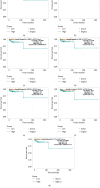Identification of Genes Associated with the Metastasis of Pheochromocytoma/Paraganglioma Based on Weighted Gene Coexpression Network Analysis
- PMID: 32090084
- PMCID: PMC7025031
- DOI: 10.1155/2020/3876834
Identification of Genes Associated with the Metastasis of Pheochromocytoma/Paraganglioma Based on Weighted Gene Coexpression Network Analysis
Abstract
Background: Pheochromocytoma/paraganglioma (PCPG) is a benign neuroendocrine neoplasm in most cases, but metastasis and other malignant behaviors can be observed in this tumor. The aim of this study was to identify genes associated with the metastasis of PCPG.
Methods: The Cancer Genome Atlas (TCGA) expression profile data and clinical information were downloaded from the cbioportal, and the weighted gene coexpression network analysis (WGCNA) was conducted. The gene coexpression modules were extracted from the network through the WGCNA package of R software. We further extracted metastasis-related modules of PCPG. Enrichment analysis of Biological Process of Gene Ontology and Kyoto Encyclopedia of Genes and Genomes was carried out for important modules, and survival analysis of hub genes in the modules was performed.
Results: A total of 168 PCPG samples were included in this study. The weighted gene coexpression network was constructed with 5125 genes of the top 25% variance among the 20501 genes obtained from the database. We identified 11 coexpression modules, among which the salmon module was associated with the age of PCPG patients at diagnosis, metastasis, and malignancy of the tumors.
Conclusion: WGCNA was performed to identify the gene coexpression modules and hub genes in the metastasis-related gene module of PCPG. The findings in this study provide a new clue for further study of the mechanisms underlying the PCPG metastasis.
Copyright © 2020 Qisheng Su et al.
Conflict of interest statement
The authors declare that there are no conflicts of interest regarding the publication of this article.
Figures





References
MeSH terms
LinkOut - more resources
Full Text Sources
Medical

